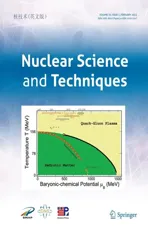Anisotropy flows in Pb-Pb collisions at LHC energies from parton scatterings with heavy quark trigger
2022-05-13HaiWangJinHuiChen
Hai Wang · Jin-Hui Chen
Abstract By implementing an additional heavy quarkantiquark pair production trigger in a multiphase transport(AMPT)model,we study the effect on anisotropy flows of identified particles with a focus on charged particles and quarkonium (J/Ψ and Υ). A systematic increase in the collision rate for active partons in the AMPT model with such an implementation has been observed. It leads to a slight increase of identified particles anisotropy flows as a function of transverse momentum (pT) and rapidity, and gives a better description of the experimental data of elliptic flow toward larger pT. Our approach provides an efficient way to study the heavy quark dynamics in the AMPT model at LHC energies.
Keywords Heavy-ion collision · Quark-gluon plasma ·Quarkonium · Collective flow
1 Introduction
In nuclear-nucleus collisions at the relativistic heavy ion collider(RHIC)and large hadron collider(LHC),a system of color deconfinement, known as quark-gluon plasma(QGP),is expected to be produced[1,2].QGP is an almost perfect fluid in the sense that its shear viscosity to entropy density ratio is close to the minimum value[3,4].Because the volume and lifetime of the QGP may be much larger and longer than those given by the confinement scale(≈1/ΛQCD), it is expected that the collective flow of partons should arise and have observable consequences that provide information on the dynamics in the QGP [5].Studies on the anisotropic flow of particle production have contributed significantly to the characterization of the system created at RHIC and LHC [5]. Using a general Fourier series decomposition of the azimuthal distribution of the emitted particles,

anisotropic flow is quantified using coefficients vnand the corresponding symmetry planes Ψn[6],where φ represents the azimuthal angle of the emitted particles in the momentum space. Systematic measurements of the correlations and fluctuations of vncoefficients and Ψnhave been performed in Refs. [7-13]. Comprehensive comparisons with theoretical model calculations provide critical information on the event average initial density distribution in the nuclear overlap region, as well as its connection to QGP dynamics [14-19].
Charm and bottom quarks are important probes for the QGP.They were mainly produced in the initial state of the hard-scattering process prior to QGP formation and survived throughout the evolution stage of the QGP.Quarkonia are bound states of heavy flavor quark-antiquark pairs,which are believed to be suppressed because of the color screening effect in the deconfined interior of the interaction region[20].They offer a complementary way to study the interaction of the heavy flavor with the medium and, thus, independently shed light on the properties of QGP [21-23]. Dozens of measurements in this direction have been carried out, and rich physical information has been delivered [24-31], with a clear future direction [21].
To study the characteristics of the QGP and its evolution toward chemical and thermal equilibrium,it is necessary to derive transport equations for quarks and gluons when they are in equilibrium and pre-equilibrium[32].There have been several studies on deriving relativistic abelian and nonabelian transport and constraint equations for the relativistic gauge covariant Wigner operator for color particles interacting via SU(N) gauge fields. This indicates that viscous hydrodynamic models can describe the transverse momentum spectra of light-flavor hadrons and distribution in the azimuthal angle for low pT [16, 33]. On the other hand,transport models have been applied to study the evolution of QGP medium[34].Owing to its relatively small cross section,a large event sample is required to study charm or even bottom quark transport in the QGP within hydrodynamics calculations or transport model simulations.In this study,we implement an additional heavy quark-antiquark pair production trigger in a multiphase transport(AMPT)model to study the dynamics of charm and bottom quarks in a dense light quark soup. This significantly improves the charm or bottom quark simulation efficiency,and it will be closer to the data at LHC energies because of a large charm quark production cross section[21].
2 Transport models of heavy flavor
We employed the AMPT model with the string melting version(v2.265)to simulate the collective motion of heavy quarkonium in Pb-Pb collisions at LHC energies. The AMPT model is a hybrid model consisting of fluctuating initial conditions, parton elastic scattering, quark hadronization, and hadronic interaction [34]. It has been used extensively to describe the dynamics of heavy-ion collisions at RHIC and LHC energies in some recent publications [35-42]. For a detailed description of the AMPT model, please refer to Ref. [34] and Ref. [43] for a summary of recent developments.
In the AMPT model, the initial production of heavy quarks is handled using the HIJING two-component model[44]. It includes pair productions (q+ ¯q →Q+ ¯Q,g+g →Q+ ¯Q) and gluon splitting (g →Q+ ¯Q) with a cross section in perturbative quantum chromodynamics(QCD) at leading order:

Here, y1and y2are the rapidities of the two produced partons, the K factor aims to account for higher-order corrections of heavy quark production,a and b refer to the types of interacting partons in the initial state,x denotes the nucleon momentum fraction taken by the interaction parton, μF represents the factorization scale, fais the parton distribution function of parton type a in a nucleon, and σab→Q¯Qis the cross section for parton types a and b to produce the heavy quark pair [44]. Because the cross section of heavy quark production, especially for the bottom quark, is several orders of magnitude smaller than that of light quarks in heavy-ion collisions at LHC energies, it calls for a trigger for heavy quark production to increase the simulation efficiency. The algorithm was originally developed by Wang and Gyulassy [44] and was extended to study the bottom quark dynamics in the QGP in this study.We refer to the details in Refs.[44]and[45]and do not repeat them here.
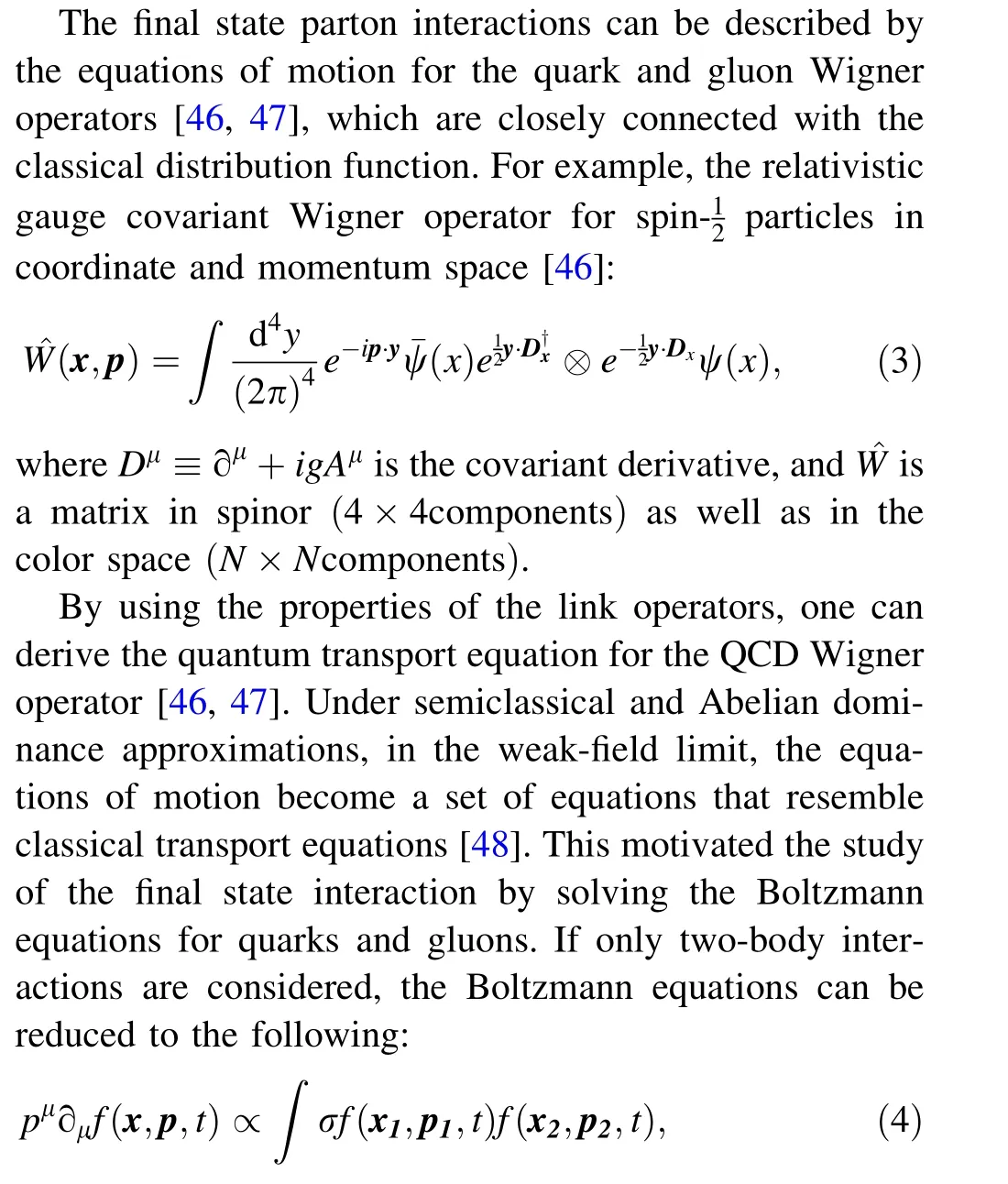


3 Results and discussion
To follow the parton scattering history in the AMPT model, we define Nscat.as the number of two-body elastic scatterings suffered by a parton. The Nscat.distribution of the active partons (Nscat.> 0) is shown in Fig. 1. The distributions from the AMPT model with an enhanced heavy quark trigger are flatter than those in the normal AMPT calculation, which suggests a larger scattering possibility for partons with enhanced heavy quark triggers in the event.The effect is rather small for the charm quark scenario and more significant for the bottom quark scenario.mid-rapidity, and close to zero at higher rapidity. The calculation appears to agree with the data at forward rapidity [31]. The value of J/Ψ v2is larger than Υ and exhibits similar rapidity dependence. However, it underpredicts the data at forward rapidity. This deviation may originate from the missing dissociation and regeneration mechanisms for heavy quarkonium in the AMPT. Further studies are required to implement these effects in the AMPT model.
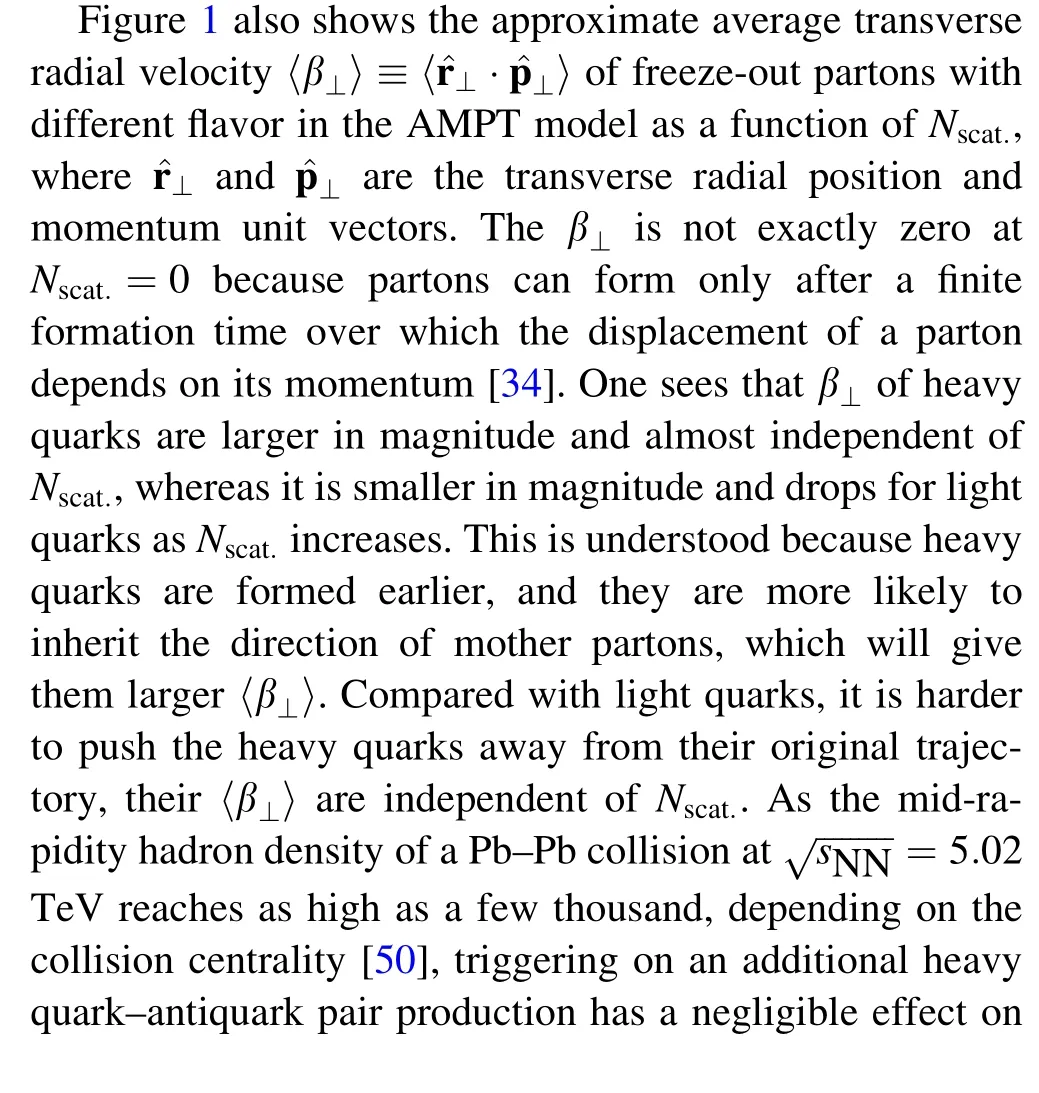

Fig. 1 (Color online) AMPT simulations of: a normalized parton scattering distributions of active quarks;b mean transverse velocity of freeze-out quarks in Pb-Pb collisions at =5.02 TeV and 5-60% centrality, where normal, w/ c-trig., and w/ b-trig. represent normal AMPT, normal AMPT with triggering an additional charm quark-antiquark pair production, and normal AMPT with triggering an additional bottom quark-antiquark pair production, respectively
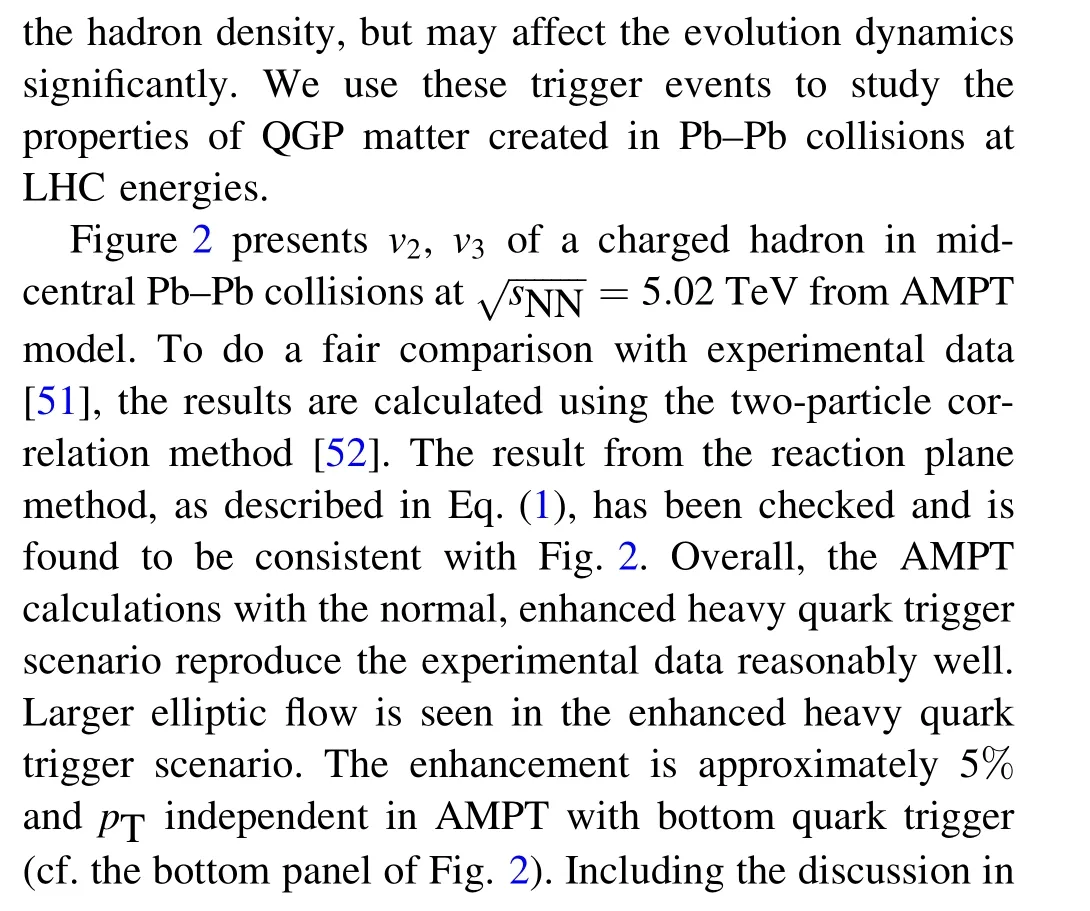

Fig. 2 Charged particles elliptic flow (v2) and triangular flow (v3) in mid-central Pb-Pb collisions at=5.02 TeV from the AMPT model with normal,enhanced heavy quark production trigger settings.The filled points represent experimental data for comparison [51]


Fig. 3 (Color online) Heavy flavor quarkonia v2(pT) of mid-rapidity and forward rapidity in Pb-Pb collisions at=5.02 TeV from the AMPT model with enhanced heavy quark-antiquark pair trigger settings. The centralities were chosen to be the same as those in the experimental measurement [31, 53]


Fig. 4 (Color online) AMPT model simulations on hadron v2(η) in Pb-Pb collisions at =2.76 and 5.02 TeV.The centralities and pT bins were chosen to be the same as the experimental data[31,54].Different model configurations were applied in the charge hadron calculation, whereas only the heavy quark-antiquark pair trigger settings were used for studying J/Ψ and Υ
The enhanced heavy quark-antiquark pair production event can also be applied to study the direct flow (v1) of quarkonium. This represents a new probe for studying the strong electromagnetic field effect of hot QCD matter via v1measurement, particularly on the difference in v1(η)between the particle and its antiparticle [56-58]. Measurements of the open charm meson v1(η) show a difference in the slopes of D0and ¯D0, but with a different sign from RHIC to LHC[55,59,60].The origin of this physics is still debated.Because the electromagnetic field effect has not been implemented in the AMPT model, we consider the v1(η) of J/Ψ and Υ instead of the v1difference between the particle and antiparticle in our current framework. In this aspect, we used the coordinate system of the model with the x-axis along the impact parameter direction(b)of each event in the transverse plane,with the center of the projective and target nuclei at the transverse coordinates (b/2, 0) and (-b/2,0). The direction of the projectile momentum specifies the z-axis;consequently,the total angular momentum of the system is along the -y

Fig. 5 (Color online) AMPT model calculations on hadron v1(η) in Pb-Pb collisions at =5.02 TeV. The charged hadron result is scaled by a factor of 10 for comparison with the experimental data[55]

4 Summary
In summary, we have implemented an additional heavy flavor quark-antiquark pair production trigger in the AMPT model to study their dynamics in hot and dense media created in high-energy heavy-ion collisions. In this study, we have focused on the heavy flavor quarkonium anisotropy flows in Pb-Pb collisions at LHC energies.The new implementation presents a systematic increase in the flow coefficients as a function of pT and η in comparison with the result from the normal AMPT model and provides an efficient way to study quarkonium dynamics with relatively small event samples. It describes the charged particle, J/Ψ, and Υ v2reasonably well. Future efforts are required to include more realistic dynamics in the AMPT model, such as the dissociation and regeneration of heavy quarkonium production at LHC energies.
AcknowledgementsDiscussions with Dr. Hui Li are gratefully acknowledged.
Author ContributionsAll authors contributed to the study conception and design. Material preparation, data collection, and analysis were performed by Hai Wang and Jin-Hui Chen.The first draft of the manuscript was written by Hai Wang and Jin-Hui Chen, and all authors commented on previous versions of the manuscript. All authors read and approved the final manuscript.

15. J.L. Nagle, W.A. Zajc, Small system collectivity in relativistic hadronic and nuclear collisions. Ann. Rev. Nucl. Part. Sci. 68,211-235 (2018). https://doi.org/10.1146/annurev-nucl-101916-123209
16. C.Shen,L.Yan,Recent development of hydrodynamic modeling in heavy-ion collisions. Nucl. Sci. Tech. 31, 122 (2020). https://doi.org/10.1007/s41365-020-00829-z
17. S.Wu,C.Shen,H.Song,Dynamical exploring the QCD matter at finite temperatures and densities-a short review.Chin.Phys.Lett.38, 081201 (2021). https://doi.org/10.1088/0256-307X/38/8/081201
18. Z.Han,B.Chen,Y.Liu,Critical temperature of deconfinement in a constrained space using a bag model at vanishing baryon density. Chin. Phys. Lett. 37, 112501 (2020). https://doi.org/10.1088/0256-307X/37/11/112501
19. R.H. Fang, R.D. Dong, D.F. Hou et al., Thermodynamics of the system of massive Dirac fermions in a uniform magnetic field.Chin. Phys. Lett. 38, 091201 (2021). https://doi.org/10.1088/0256-307X/38/9/091201 20. T. Matsui, H. Satz, J/ψ suppression by Quark-Gluon plasma formation. Phys.Lett. B 178,416-422 (1986).https://doi.org/10.1016/0370-2693(86)91404-8
21. N.Brambilla,S.Eidelman,B.Heltsley et al.,Heavy quarkonium:progress, puzzles, and opportunities. Eur. Phys. J. C 71, 1534(2011). https://doi.org/10.1140/epjc/s10052-010-1534-9
22. Z.B. Tang, W.M. Zha, Y.F. Zhang, An experimental review of open heavy flavor and quarkonium production at RHIC. Nucl.Sci. Tech. 31, 81 (2020). https://doi.org/10.1007/s41365-020-00785-8
23. J. Zhao, K. Zhou, S. Chen et al., Heavy flavors under extreme conditions in high energy nuclear collisions. Prog. Part. Nucl.Phys. 114, 103801 (2020). https://doi.org/10.1016/j.ppnp.2020.103801

33. B. Schenke, S. Jeon, C. Gale, (3+1)D hydrodynamic simulation of relativistic heavy-ion collisions. Phys. Rev. C 82, 014903(2010). https://doi.org/10.1103/PhysRevC.82.014903
34. Z.W.Lin,C.M.Ko,B.A.Li et al.,A Multi-phase transport model for relativistic heavy ion collisions. Phys. Rev. C 72, 064901(2005). https://doi.org/10.1103/PhysRevC.72.064901
35. C. Zhang, Z.W. Lin, Left-right splitting of elliptic flow due to directed flow in heavy ion collisions. arXiv:2109.04987
36. D.Shen,J.Chen,Z.W.Lin,The effect of hadronic scatterings on the measurement of vector meson spin alignments in heavy-ion collisions. Chin. Phys. C 45, 054002 (2021). https://doi.org/10.1088/1674-1137/abe763
37. L. Zheng, G.H. Zhang, Y.F. Liu et al., Investigating high energy proton proton collisions with a multi-phase transport model approach based on PYTHIA8 initial conditions. Eur. Phys. J. C 81, 755 (2021). https://doi.org/10.1140/epjc/s10052-021-09527-5
38. C.Z. Wang, W.Y. Wu, Q.Y. Shou et al., Interpreting the chargedependent flow and constraining the chiral magnetic wave with event shape engineering. Phys. Lett. B 820, 136580 (2021).https://doi.org/10.1016/j.physletb.2021.136580
39. H. Wang, J. Chen, Study on open charm hadron production and angular correlation in high-energy nuclear collisions. Nucl. Sci.Tech. 32, 2 (2021). https://doi.org/10.1007/s41365-020-00839-x
40. X.L.Zhao,G.L.Ma,Y.G.Ma et al.,Validation and improvement of the ZPC parton cascade inside a box. Phys. Rev. C 102,024904 (2020). https://doi.org/10.1103/PhysRevC.102.024904
41. T.Shao,J.Chen,C.M.Ko et al.,Enhanced production of strange baryons in high-energy nuclear collisions from a multiphase transport model. Phys. Rev. C 102, 014906 (2020). https://doi.org/10.1103/PhysRevC.102.014906
42. C. Zhang, L. Zheng, F. Liu et al., Update of a multiphase transport model with modern parton distribution functions and nuclear shadowing. Phys. Rev. C 99, 064906 (2019). https://doi.org/10.1103/PhysRevC.99.064906
43. Z.W. Lin, L. Zheng, Further developments of a multi-phase transport model for relativistic nuclear collisions. Nucl. Sci.Tech.32,113(2021).https://doi.org/10.1007/s41365-021-00944-5
44. X.N. Wang, M. Gyulassy, HIJING: a Monte Carlo model for multiple jet production in p p,p A and A A collisions.Phys.Rev.D 44, 3501-3516 (1991). https://doi.org/10.1103/PhysRevD.44.3501

47. H.T. Elze, M. Gyulassy, D. Vasak, Transport equations for the QCD Gluon Wigner operator.Phys.Lett.B 177,402-408(1986).https://doi.org/10.1016/0370-2693(86)90778-1
48. B. Zhang, ZPC 1.0.1: a Parton cascade for ultrarelativistic heavy ion collisions. Comput. Phys. Commun. 109, 193-206 (1998).https://doi.org/10.1016/S0010-4655(98)00010-1
49. B. Zhang, M. Gyulassy, C.M. Ko, Elliptic flow from a parton cascade.Phys.Lett.B 455,45-48(1999).https://doi.org/10.1016/S0370-2693(99)00456-6


56. S.K.Das,S.Plumari,S.Chatterjee et al.,Directed flow of charm quarks as a witness of the initial strong magnetic field in ultrarelativistic heavy ion collisions. Phys. Lett. B 768, 260-264(2017). https://doi.org/10.1016/j.physletb.2017.02.046
57. U.Gu¨rsoy,D.Kharzeev,E.Marcus et al.,Charge-dependent flow induced by magnetic and electric fields in heavy ion collisions.Phys. Rev. C 98, 055201 (2018). https://doi.org/10.1103/Phys RevC.98.055201
58. S. Chatterjee, P. Bo˙zek, Large directed flow of open charm mesons probes the three dimensional distribution of matter in heavy ion collisions.Phys.Rev.Lett.120,192301(2018).https://doi.org/10.1103/PhysRevLett.120.192301
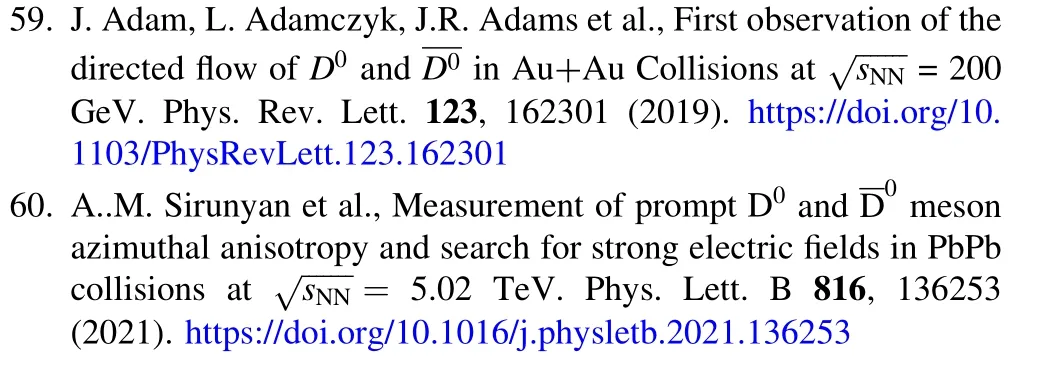
杂志排行
Nuclear Science and Techniques的其它文章
- Development and application of a multi-physics and multi-scale coupling program for lead-cooled fast reactor
- A novel approach for radionuclide diffusion in the enclosed environment of a marine nuclear reactor during a severe accident
- Investigation of combined degrader for proton facility based on BDSIM/FLUKA Monte Carlo methods
- Anisotropic flow in high baryon density region
- Effect of relaxation time on the squeezed correlations of bosons for evolving sources in relativistic heavy-ion collisions
- Superconducting multipole wiggler with large magnetic gap for HEPS-TF
